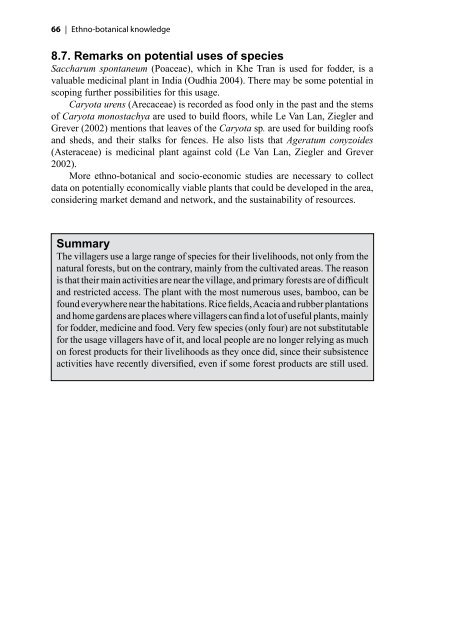English 2.28MB - Center for International Forestry Research
English 2.28MB - Center for International Forestry Research
English 2.28MB - Center for International Forestry Research
You also want an ePaper? Increase the reach of your titles
YUMPU automatically turns print PDFs into web optimized ePapers that Google loves.
| Ethno-botanical knowledge<br />
8.7. Remarks on potential uses of species<br />
Saccharum spontaneum (Poaceae), which in Khe Tran is used <strong>for</strong> fodder, is a<br />
valuable medicinal plant in India (Oudhia 2004). There may be some potential in<br />
scoping further possibilities <strong>for</strong> this usage.<br />
Caryota urens (Arecaceae) is recorded as food only in the past and the stems<br />
of Caryota monostachya are used to build floors, while Le Van Lan, Ziegler and<br />
Grever (2002) mentions that leaves of the Caryota sp. are used <strong>for</strong> building roofs<br />
and sheds, and their stalks <strong>for</strong> fences. He also lists that Ageratum conyzoides<br />
(Asteraceae) is medicinal plant against cold (Le Van Lan, Ziegler and Grever<br />
2002).<br />
More ethno-botanical and socio-economic studies are necessary to collect<br />
data on potentially economically viable plants that could be developed in the area,<br />
considering market demand and network, and the sustainability of resources.<br />
Summary<br />
The villagers use a large range of species <strong>for</strong> their livelihoods, not only from the<br />
natural <strong>for</strong>ests, but on the contrary, mainly from the cultivated areas. The reason<br />
is that their main activities are near the village, and primary <strong>for</strong>ests are of difficult<br />
and restricted access. The plant with the most numerous uses, bamboo, can be<br />
found everywhere near the habitations. Rice fields, Acacia and rubber plantations<br />
and home gardens are places where villagers can find a lot of useful plants, mainly<br />
<strong>for</strong> fodder, medicine and food. Very few species (only four) are not substitutable<br />
<strong>for</strong> the usage villagers have of it, and local people are no longer relying as much<br />
on <strong>for</strong>est products <strong>for</strong> their livelihoods as they once did, since their subsistence<br />
activities have recently diversified, even if some <strong>for</strong>est products are still used.

















